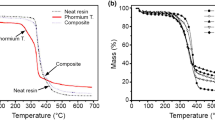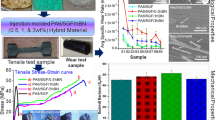Abstract
Composites were prepared by dispersing Alumina platelets of polygonal shape having a thickness of 200 nm and size of 5–10 μm in epoxy (LY 556) matrix using sonication. Good dispersion of the platelets was observed through scanning electron microscopy (SEM). The quasi-static plane-strain fracture toughness and tensile properties of the composites were determined for platelet volume fraction varying from 0% to 10%. The results indicated that addition of the platelets give considerable improvement in fracture toughness and good improvement in the elastic modulus of epoxy. For 10% volume fraction of the platelets, the fracture toughness improved by 110% where as the improvement in elastic modulus was 78%. However there was an associated reduction of 53% in tensile strength and 73% in failure strain. SEM of fractured surface was carried out to understand the various mechanisms responsible for the improvement in fracture toughness. By appropriately accounting for the orientation and stacking effects of the platelets, the applicability of predictive models, such as the Halpin-Tsai and Mori-Tanaka, for estimating the composite modulus is demonstrated.











Similar content being viewed by others
References
Kojima Y, Usuki A, Kawasumi M, Okada A, Kurauchi T, Kamigaito O (1993) J Appl Polym Sci 49:1259
Kojima Y, Usuki A, Kawasumi M, Okada A, Kurauchi T, Kamigaito O (1993) J Mater Res 8:1185
Agag T, Koga T, Takeichi T (2001) Polymer 42:3399
Chen TK, Tien YI, Wei KH (2000) Polymer 41:1345
Daniel IM, Miyagawa H, Gdoutos EE, Luo JJ (2003) Exp Mech 43:348
Sue HJ, Gam KT, Bestaoui N, Clearfield A, Miyamoto M, Miyatake N (2004) Acta Mater 52:2239
Xiaodong L, Hongsheng G, Scrivens AW, Dongling F, Thakur V, Sutton MA, Reynolds AP, Myrick ML (2005) Nanotechnology 16:2020
Chisholm N, Mahfuz H, Rangari VK, Ashfaq A, Jeelani S (2005) Comp Struct 67:115
Park SS, Bernet N, Roche DL, Hahn HT (2003) J Comp Mat 37:465
Singh RP, Zhang M, Chan D (2002) J Mater Sci 37:781
Zhang M, Singh RP (2002) Mater Lett 58:408
Evora VMF, Shukla A (2003) Mater Sci Eng A 361:358
D638-03, Standard test method for tensile properties of plastics, Annual Book of ASTM Standards. American Society of Testing and Materials, West Conshohocken (2004)
D5045-99, Standard test methods for plane-strain fracture toughness and energy release rate of plastic materials, Annual Book of ASTM Standards. American Society of Testing and Materials, West Conshohocken (2004)
Cai H, Faber KT (1992) J Am Ceram Soc 75:3111
Leung CKY, Li VC (1992) J Mech Phys Solids 40(6):1333
Halpin JC (1969) J Comp Mat 3:732
Halpin JC, Kardos JL (1976) Polym Eng Sci 16:344
Eshelby JD (1957) Proc Roy Soc A241:376
Mori T, Tanaka K (1973) Acta Metall 21:571
van Es M, Xiqiao F, van Turnhout J, van der Giessen E (2001) Specialty polymer additives: principles and applications. Blackwell Science; Chapter 21
Tandon GP, Weng GJ (1984) Polym Compos 5:327
Hui CY, Shia D (1998) Polym Eng Sci 38:774
Acknowledgements
The authors acknowledge the financial support of Aeronautical Research and Development Board, India (ARDB/AE/19990054) and Ministry of Human Resource Development, India (MHRD-ME-TAT-20030334). We also acknowledge Department of Science and Technology, India (DST/INT/US-NSF/RPO-159/04) for the financial support under the INDO-US collaboration program.
Author information
Authors and Affiliations
Corresponding author
Rights and permissions
About this article
Cite this article
Shukla, D.K., Parameswaran, V. Epoxy composites with 200 nm thick alumina platelets as reinforcements. J Mater Sci 42, 5964–5972 (2007). https://doi.org/10.1007/s10853-006-1110-8
Received:
Accepted:
Published:
Issue Date:
DOI: https://doi.org/10.1007/s10853-006-1110-8




